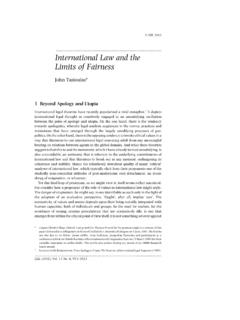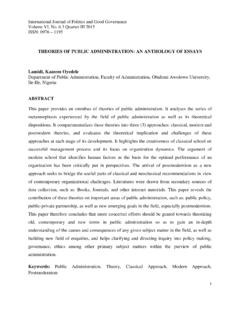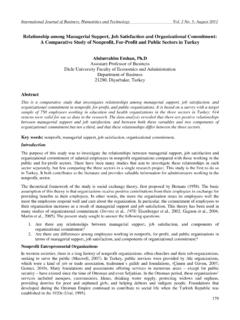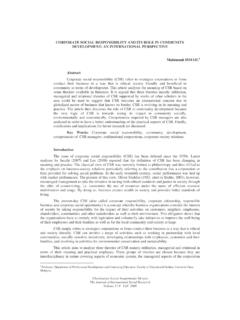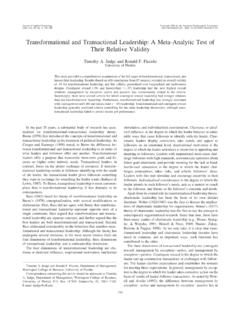Transcription of The influence of stakeholder groups on organizational ...
1 1 The influence of stakeholder groups on organizational decision -making in public hospitals by Egil Marstein Dissertation for the Degree of Series of Dissertations 2/2003 BI Norwegian School of Management Department of Leadership and Organisational Management 2 Egil Marstein: The influence of stakeholder groups on organizational decision -making in public hospitals Egil Marstein 2003 Series of Dissertations 2/2003 ISBN: 82 7042 600 8 ISSN: 1502 2099 Norwegian School of Management BI 580 N-1302 Sandvika Phone: +47 67 55 70 00 Printing: Nordberg Hurtigtrykk To be ordered from: Norli Phone: +47 67 55 74 51 Fax: +47 67 55 74 50 Mail: 3 Abstract stakeholder pressure, sector turbulence and crisis make up the troublesome agenda within the public hospital sector. Sector deficiencies challenge the governance legitimacy and its organizational rationale.
2 On-going political and public debates call for organizational prescriptions revising traditional institutional configurations. The thesis identifies how a multitude of stakeholder groups influence organizational decision -making in public hospitals. stakeholder analysis is based on the belief that certain reciprocal relationships exist between an organization and certain groups and individuals (Ginter, Swayne, and Duncan 1989). These groups and individuals are so-called stakeholders as they are considered to have a stake or claim in the outcome of decision -making. A lacking empirical foundation and an abundance of normative contentions mark the present state of affairs on stakeholder theory. This disparity in research focus curtails the formulation of descriptive and instrumental propositions tied to stakeholder management.
3 Although an instrumental justification for stakeholder theory originally has been established by Freeman (Freeman 1984), some commentators argue that these are inadequate to serve as a theoretical basis (Ogden and Watson 1999). Donaldson advocates that managers should acknowledge the value of diverse stakeholder interests and should attempt to respond to them within a mutually supportive framework, because that is a moral requirement for the legitimacy of the management function (Donaldson and Preston 1995). Recent normative developments in stakeholder theory tie philosophical views into operational contexts. Proponents of the latter may be found in the theory of the common good (Aragandona 1998) tied to Cludt s (Cludts 1999) social system theorem, both arguing for a balancing of constituent interests relative to the organization s societal relations and the nature of its services.
4 The thesis presents a contextual analysis that makes an exposition of the structural contingencies of the Norwegian welfare state. A descriptive/ empirical analysis of the public hospital s decision -making processes provides insight into how stakeholder groups shape the premises of the public hospital s value creation-process. The thesis theoretical propositions are vested in hospitals efforts to achieve a stakeholder balance between competing constituent interests. A thesis proposal on descriptive/empirical stakeholder theory is exempt from normative prescriptions on the intrinsic value of all stakeholder groups . The stakeholder theory of detachment 1 1 See thesis section Theoretical contributions . 4reflects thesis findings that stakeholder management takes place in a departmentalized fashion without an integrated operations perspective.
5 A conceptualization of stakeholder compliance 2 is introduced and vizualises the embedded nature of stakeholder management in public hospitals. The model is grounded in the empirical accounts on how stakeholder management employs differentiated decision processing techniques at different organizational levels to achieve an optimum balance between competing constituent interests. The thesis summary and conclusions culminate in a set of implications. These address the need for a renewed national discourse on the governance of public hospitals. The thesis empirical findings on the consequences of non-integrated stakeholder management, call for reviews of governance models and managerial practices. Empirical evidence confirms a pattern of decisional sedimentation in which executive-, operational- and ward hospital management work strategically detached on issues of overall strategic importance.
6 The thesis contends that hegemonic and autonomous management make room for staged and manipulative stakeholder behavior. As generalized through this empirical field study, the operational practices of public hospitals exempts authorities from the exercise of rational choice. 2 See thesis section Theoretical contributions . 5 Acknowledgements Having completed The Doctoral Study Program at The Norwegian School of Management (NSM) has been both a challenging and an inspiring venture. Enduring was made possible through the perseverance of a number of individuals. My thesis committee, consisting of professors Jan Grund, Ole Berg and Johan Olaisen, has been there all along to provide direction and inspiration. Professor Jan Grund, the pro-rector at the NSM, counseled and coached while sharing with me and providing access to his public health sector network.
7 Professor Ole Berg at the University of Oslo, Center for Health Administration has been generous in letting me draw on his vast amount of theoretical knowledge and contextual insight. Professor Johan Olaisen of the NSM expanded my methodological comprehension significantly improving upon the quality of my research strategy. And finally there was Professor Mark Kriger, professor of Strategy, who in addition to coaching me in the direction of hospital strategizing, made doctoral classes topical events. My personal and bona fide support team has been invaluable on my road to accomplishing both the regimen of the doctoral program and the thesis project itself. Astrid Cooper with Research International has been a most valued advisor on research procedures and analysis as well as offering important manuscript advice.
8 My many friends and clients in the hospital sector over many years have cheered me on. However, the key to the successful completion has been my family support team. My three gifted and lovely young adult children, Lilly-Anne, Erik Olav and yvind, who themselves have gone through university training, have showered me with their inspiration. From fine arts and architecture to philosophy and the history of ideas. Their special gifts have helped me develop my own research venue and program strategy. Last but not least. My wife of many years, Liv Ingrid has been my special empirical treasure. Her background as a surgical nurse has helped me comprehend some of the socio-cultural traits unique to the public hospital. I especially wish to credit the many informants who have shared their experiences with me.
9 It opened up for what became an intensive investigation of such an important sector within our welfare state. I trust that the thesis contributions may have made it worth their while. It exhibits how complicated and challenging it is to fulfill the societal obligations of public health deliveries. Thesis summary and conclusions reflect a public sector in need of continued system improvements. However, the ailments diagnosed and implications outlined do not reflect negatively upon the many individuals who dedicate their careers to improve upon the quality of life of 6patients and their next of kin. A continued public discourse on public health policies is the only guarantee for the best of cures for system anomalies. It is therefore hoped that the thesis may serve as a basis for public debate while also inspiring future research on the contingencies of hospital institutions and the multiplicity of stakeholder group interests.
10 Sandvika, 3rd July 2003 Egil Marstein 7 Table of contents Table of 7 List of tables .. 12 List of illustrations .. 14 1 Introduction .. 15 Intent of the study .. 15 Thesis 17 2 Thesis focus and rationale .. 19 Introduction .. 19 A stakeholder rationale for the public 20 The dynamism of the stakeholder fit .. 20 The conditional governance .. 22 The omnipresence of 25 The influx of societal medicalization (Illich 1974 p. 39).. 28 The presence of Corporatism and other proxy 30 The value chain of the public 32 organizational decision -making in hospitals .. 33 3 The public 37 A historical review of the hospital 37 Introduction .. 37 From pre modern- to late modern hospitals .. 37 The governance model.

